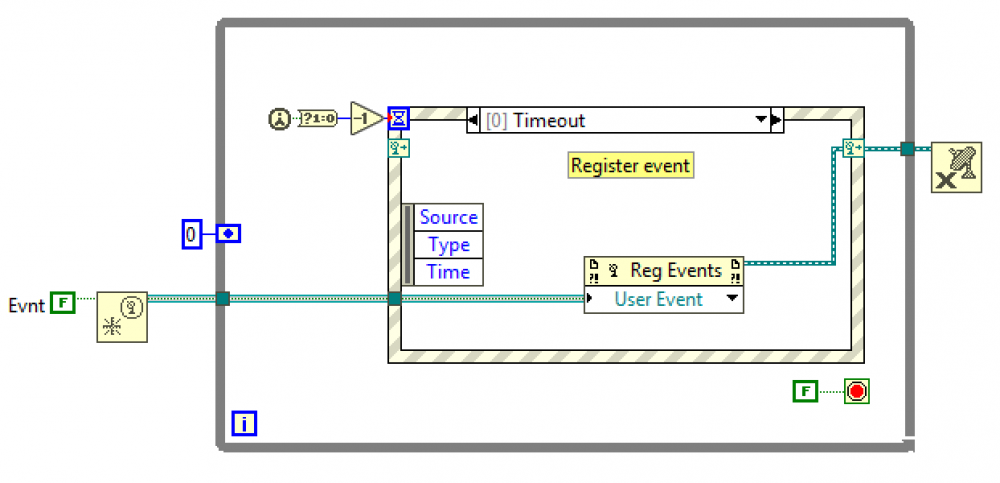Leaderboard
Popular Content
Showing content with the highest reputation on 03/03/2018 in all areas
-
To my understanding, the data type is fixed at design time but the Event Registrations are run-time dynamic. I think Jack Dunaway's excellent examples on User Events showed this.1 point
-
It's too bad they didn't "fix" it by allowing this (where I take Shaun's original code and just delete the constant): Assuming an internal shift-register behavior in the Event Structure, then this "uninitialized shift register" behaves in a perfectly dataflow-like fashion, and it's even simpler to code. Unfortunately, it's also broken, as the Event Structure wont adapt to the type input to the right-hand Dynamic Event Terminal.1 point
-
QUOTE(Daklu @ Aug 14 2007, 01:47 PM) The thing about accessing properties of array elements is that the properties and methods are all treated as the same. This means you can't disable, blink, etc individual array elements because they would all be disabled,blink,etc. You've also found that it requires some work to figure out if a particular element has changed without comparing the old values with the new values. Even with your event handling for the select button, you aren't testing to see *which* select button was clicked, just to see if *any* of them were clicked inside the array. For future expandability and to keep the code sane, I would choose a cluster versus an array for this application's front panel UI with 8 individual typedef'ed clusters inside. Now, this doesn't mean that your program can't take the cluster values that are in the UI and convert them into array elements when needed (using the cluster to array primative) to do "array" type operations internally... that's the beauty of using typedefs. Cheers!1 point
-
Sorry I'm a little late to the party on this one - just saw the link on info-labview and thought I'd respond to clear some things up here. 1) Just because NI support says something isn't intended behavior (aka "a bug"), doesn't mean it's so. For some of the more advanced features, they may be lacking full understanding of the intracacies of the behavior of the feature. This is the case here. I don't mean to criticize or demean our support folks; it's just that no one at NI other than the developer who wrote the code *REALLY* knows what the intended behavior is. 2) Jeff's description is correct. Hopefully I can clear this up a bit here, and explain why this is something that we can't eliminate in LabVIEW... When LabVIEW notifies an event structure of a "mouse up", "mouse down", or "mouse move" event, it is doing so before it has completely processed the event. The code to generate the events lies somewhere between where we get the message from the operating system, and where we hand it to the specific control that was hit for it to process and respond appropriately. In this case, that means that the "Mouse Down" and "Mouse Up" events are being given to the diagram before the control actually updates it's value as a result of the user action. This is what introduces the race condition. Because you are watching for "notify" events, the LabVIEW UI Thread (which is where all user interaction is processed) quickly notifies the event structures that they have an event in their queue, and then continues processing the action as normal (in this case, messaging the boolean that was hit and having the boolean update it's value). Depending on what thread the block diagram is running in, it is a crapshoot as to whether the read from the boolean's terminal will happen before or after the boolean responds to the mouse message and updates it's value. The reason Michael's fix with the property node works is that all property nodes switch to the UI thread, thus synchronizing the execution of the block diagram with whatever's going on in the UI thread (oftentimes forcing the diagram to run entirely in the UI thread). In this particular example, that means the current message(mouse down or up) will be fully processed before the value is read via the property node. Reads from both locals and FP terminals happen in whatever thread the diagram is executing in. So....race conditions are bad, inherently. Why don't the LabVIEW developers eliminate the possibility in this case? Well, for one, users like multi-threading. We need to allow the UI and block diagram execution to happen in seperate threads, otherwise you won't get the performance you want from your block diagram (as execution must pause every time the user moves the mouse or hits a key). The introduction of event-driven programming introduced some interesting problems, as one of the fundamental reasons for doing so was to be able to synchronize the front panel (UI) and block diagram. While allowing for this, we still want the UI to be responsive while the block diagram is executing (and vice versa). While we could halt the processing of UI messages while the diagram is handing events, or halt diagram execution while LabVIEW processes interactions with the UI, both these would have a negative impact on performance. This makes eliminating race conditions quite difficult, as it takes away all of our "easy" solutions. In response to Louis' point: This is a great analogy, except that there is no resource contention or multi-threading going on in the real world. Unfortunately, electrons travel much faster than computer processors execute lines of code. Imagine a physical system where the button push itself doesn't connect the circuit, but rather intiates some sequence that takes a measurable amount of time to finish that ends up connecting the circuit. In this scenario, it is completely possible (well, theoretically), to push the button, and after pushing it, read the state of the circuit and see that it is still "open". In software, the click on the button does not simultaneously change it's value like it does in the real-world. And, even in the real world, there is a delay between the closure of the circuit and the flow of current through the entire wire. While very smalll, there is a window where a current or voltage reading would show the circuit as being "open" rather than closed, after the button has been pressed. (I'm not a physicist, I only took 12 hours of physics in college, so I could be wrong here, and if so, please don't berate me too badly). This would mean that we halt block diagram execution while the UI thread is processing ANY message from the operating system. Clearly, many users would be up in arms about this. Even if we could restrict this behavior to cases where the event structure is involved and the OS message is specifically related to a user interaction, it would introduce a non-determinism that, in my opinion, would be unacceptable. We *could* delay the generation of events until the specific OS message is completely handled by all LV objects, but that would mean that you would get "Mouse Down" events after the value has already been updated. And what of filter events, where the diagram must take part in the event-handling before the default LV actions are taken? Those events must get handed off to the diagram before the default LV handling occurs, so we clearly can't defer it until later to get the behavior you describe. If we generate filter events in their current locations, but notify events (which don't synchronize the front panel and block diagram) after the default LV handling has occurred, then the diagram will be handed events out of order. For example, if the diagram was watching for Mouse Down?, Mouse Down, Value Change? (<- a filter event for this does not exist, but it has been discussed since we first started considering adding event-driven programming), and ValueChange, and the user clicks on the boolean, the order of event generation would be: Mouse Down? -> Value Change? -> Mouse Down -> Value Change. This does not make sense in the context of how we've defined the order of events in LabVIEW. I suppose we could change that, but I don't think this ordering makes sense in any context. I think a good point is made here, however, that users of LabVIEW should not have to worry about race conditions and that things should simply work as expected. Users should not have to accept "unexpected" behavior simply as a result of some weird implementation detail due to the architecture of the LabVIEW code base. I am a big proponent of this philosophy, and have made my job more difficult by being unwilling to simply say "customers will learn to work around it", solely because it's difficult to implement the "natural" solution. However, we do need to recognize that the LabVIEW code base is almost 20 years old, and it most definitely was not architected to allow for users' block diagrams to participate in event-handling. While it may be possible to re-write LabVIEW and architect it in such a way that the interface to event-driven programming we expose will work "as expected" in all cases, it most certainly would break other things in the language. We're re-writing components of LabVIEW as they become brittle, but we most definitely don't want to do the whole thing at once. I think that the event-driven programming interface we've provided does behave as documented, and the behavior we've defined is not unreasonable. It *is* an advanced feature, and with any language, if you are participating in the event-handling, you have to be very careful of what you are doing in response to those events. There are rules you must follow, and you should be aware of what exactly the event your handling *means*. We've gone through great efforts to document the event-driven programming features throroughly, as well as give many presentations on the subject, as we realize it is a difficult feature to grasp and to use effectively. However, it's very possible that we haven't been clear enough, or some behaviors aren't completly documented. If you find that's the case, please file a bug report. Hopefully this post is coherent, and possibly clears up why this is "expected" behavior. I "wrote" a reply in my head this morning, but got interrupted before I was able to type it out, so I lost a bit of my train of thought. I hope I did not come across as being defensive - I do not mean to be, and I want you all to continue to raise questions on this and challenge us to do things "right" and make programming as easy as possible for all of you. I just want to peel back the covers a bit and help y'all understand the mechanism going on and the design decisions that have been made so that more of these behaviors make sense, and hopefully you can help "share the wealth", so to speak. J1 point



